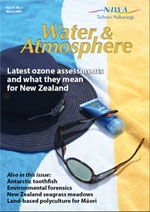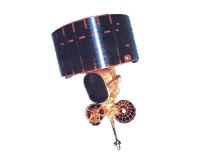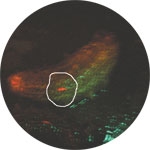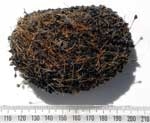PDF of this article (136 KB)

Tagging sea cucumbers
NIWA is working with the mussel farming industry to trial ‘multi-trophic co-culture’, a system where several species are raised together in ecological balance. One species is fed and the others live off the dissolved or particulate nutrients in the surrounding water.
In our design, feed is added for finfish; their faeces and any food that they miss are available for filtration by mussels; dissolved nutrients are soaked up by cultured seaweed, which in turn is food for sea urchins for roe enhancement. Faeces that settle on the seabed from finfish, mussels, and sea urchins are consumed by ranched sea cucumbers.


But how do we assess whether it is ecologically feasible to ranch sea cucumbers? If juvenile sea cucumbers are placed under finfish/mussel farms, will they stay put, or will they move off to ‘greener pastures’?
To answer this question, we had to find a way to tag sea cucumbers for release and recapture under farms. Graeme Moss from NIWA’s Mahanga Bay aquaculture facility investigated six different methods, including freeze branding, micro-sand blasting, pit-tagging, T-bar tags, and Visible Implant Fluorescent Elastomer, or VIFE for short. VIFE (developed by Northwest Marine Technology Inc., Washington) involves injecting a viscous, stretchy liquid (elastomer) into the paler underside of a sea cucumber where the elastomer forms a marker that glows under blue light. After 4 weeks in the laboratory, the best results (tag retained without mortality) were obtained with the T-bars (87%) and the VIFE technique (93%). After 3 months, tag retention had dropped to 40% for the T-bars and 87% with VIFE.
We used the VIFE technique – backed up with T–tags – and released 100 tagged sea cucumbers in Mahanga Bay to see how they dispersed from a central point. Scuba divers were able to retrieve half of the tagged sea cucumbers in two 15–m radial searches, one after 24 hours and the other after 9 days. Our next step is to release VIFE–tagged individuals under marine farms and experiment with different search patterns to optimise retrieval. Then we can statistically evaluate the feasibility of ranching sea cucumbers.
This project is funded by the FRST International Investment Opportunity Fund and we are working in collaboration with the Yellow Sea Fisheries Research Institute in China.
Read more about culturing multiple species in ‘Land-based polyculture for coastal Māori’.
For further information, contact: Dr Jeanie Stenton-Dozey, 0-3-343 8030, [email protected]
What the ...?

Looking like a small hedgehog, this peculiar object was caught in a beam trawl when NIWA staff were sampling flatfish in Te Waihora (Lake Ellesmere). Closer examination revealed not a drowned introduced mammal, but rather a very old ball of seeds from a native aquatic plant.
Before the Wahine. storm of 1968, Waihora was fringed by an extensive community of aquatic plants. While there is some evidence that the community was already slowly deteriorating, the storm certainly accelerated the cycle by uprooting the weed beds. These were primarily comprised of two species of Ruppia (lakeweed) and some Potamageton pectinalis (fennel–leaved pondweed). Since that time, the lake has been too turbid for the plants to repopulate. Where there is sufficient light in the shallows, wave action and grazing by swans rapidly removes any regenerating weed.
So, the trawled-up specimen is in fact a ball of Ruppia seed that must have gradually accumulated during the 38 years since the weed beds were destroyed by the storm. We incubated the seed ball in the laboratory and many of the seeds germinated, indicating they were still viable. Small quantities of Ruppia are occasionally seen in sheltered embayments, although it appears the plants are grazed down by waterfowl before significant communities can establish.
Currently, there is considerable interest in exploring opportunities to re-establish aquatic plants within the lake, as they provide habitat diversity and are useful for food production, trapping suspended sediments, reducing wave impacts, and assisting in nutrient uptake.
For further information, contact: Dr Don Jellyman, 0-3-343 7846, [email protected]
